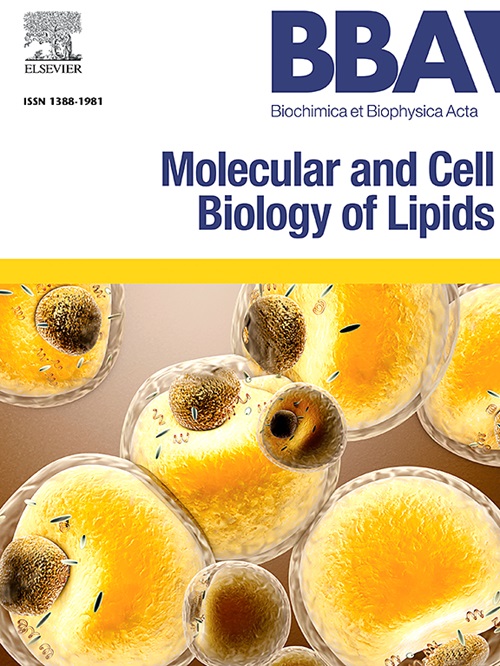Preventive effect of siphonaxanthin, a carotenoid from green algae, against diabetic nephropathy and lipid metabolism insufficiency in skeletal muscle
IF 3.3
2区 生物学
Q2 BIOCHEMISTRY & MOLECULAR BIOLOGY
Biochimica et biophysica acta. Molecular and cell biology of lipids
Pub Date : 2025-02-20
DOI:10.1016/j.bbalip.2025.159604
引用次数: 0
Abstract
Diabetic nephropathy is a complication of diabetes mellitus characterized by the gradual progression of renal insufficiency, resulting in renal failure. Approximately 15 % or more of patients with type 2 diabetes mellitus have diabetic nephropathy. Siphonaxanthin is a green algal carotenoid noted for its strong biological activities, including anti-obesity effects. In this study, we aimed to evaluate the preventive effects of siphonaxanthin on diabetic nephropathy using db/db mice as a type 2 diabetes mellitus and diabetic nephropathy model. Ingestion of AIN-93G containing 0.004 % w/w siphonaxanthin did not improve plasma creatinine and urine albumin levels but significantly mitigated renal morphological changes in diabetic mice. Moreover, siphonaxanthin restored the decreased mRNA expression of fatty acid β-oxidation-related proteins in the skeletal muscle. These results indicate that siphonaxanthin can potentially ameliorate type 2 diabetes mellitus-induced kidney damage and lipid metabolism insufficiency in skeletal muscle. This study provides a possible daily nutraceutical solution for treating diabetic nephropathy and lipid metabolic abnormalities.

绿藻类胡萝卜素虹黄质对糖尿病肾病和骨骼肌脂质代谢不足的预防作用
糖尿病肾病是糖尿病的一种并发症,以肾功能不全的逐渐发展为特征,导致肾功能衰竭。大约15%或更多的2型糖尿病患者患有糖尿病肾病。Siphonaxanthin是一种绿藻类胡萝卜素,以其强大的生物活性而闻名,包括抗肥胖作用。本研究以db/db小鼠作为2型糖尿病和糖尿病肾病模型,探讨虹黄质对糖尿病肾病的预防作用。摄入含有0.004% w/w siphonaxanthin的AIN-93G不能改善糖尿病小鼠的血浆肌酐和尿白蛋白水平,但能显著减轻肾脏形态学改变。此外,siphonaxanthin还能恢复骨骼肌中脂肪酸β-氧化相关蛋白mRNA的表达。这些结果表明siphonaxanthin可以潜在地改善2型糖尿病引起的肾损害和骨骼肌脂质代谢不足。这项研究为治疗糖尿病肾病和脂质代谢异常提供了一种可能的日常营养解决方案。
本文章由计算机程序翻译,如有差异,请以英文原文为准。
求助全文
约1分钟内获得全文
求助全文
来源期刊
CiteScore
11.00
自引率
2.10%
发文量
109
审稿时长
53 days
期刊介绍:
BBA Molecular and Cell Biology of Lipids publishes papers on original research dealing with novel aspects of molecular genetics related to the lipidome, the biosynthesis of lipids, the role of lipids in cells and whole organisms, the regulation of lipid metabolism and function, and lipidomics in all organisms. Manuscripts should significantly advance the understanding of the molecular mechanisms underlying biological processes in which lipids are involved. Papers detailing novel methodology must report significant biochemical, molecular, or functional insight in the area of lipids.

 求助内容:
求助内容: 应助结果提醒方式:
应助结果提醒方式:


